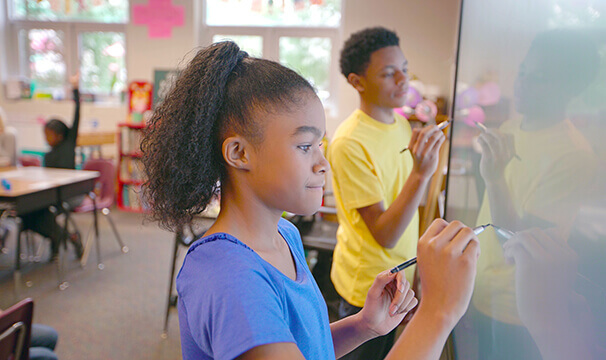In today’s diverse world, fostering an inclusive classroom environment has become a fundamental goal for educators. By creating an environment where all voices are valued and respected, you give every student an equal opportunity to learn, grow, and thrive, regardless of their backgrounds, abilities, or identities.
In this article, we’ll explore practical strategies that you can use to cultivate an inclusive classroom environment. From the way you design your curriculum to the tools and technologies you use in your classroom, every aspect of your teaching can contribute to shaping an environment that supports diversity and promotes a sense of belonging.
What is an inclusive classroom?
But the concept of an inclusive classroom goes beyond simply having a mix of students from different backgrounds in one room. It involves adapting your teaching approach to ensure the participation of all students and creating an atmosphere where every student feels valued, respected, and heard, regardless of their identity, ability, or learning preferences. It’s about acknowledging and celebrating the unique perspectives and contributions that each student brings to the table, so that everyone feels like they belong.
According to UNICEF, inclusive education celebrates human diversity and recognises the right of all students to quality education.
Understanding disability
In the context of education, inclusivity often concerns students with diverse learning needs, including students with disabilities.
Students with disability and developmental challenges might include those with learning disabilities, intellectual disabilities, sensory difficulties (those who are deaf, hard of hearing, blind or have low vision), communication and language disorders, cerebral palsy, autism, ADHD, or mental health disorders.
The impact of inclusivity on learning outcomes
According to a report by Children and Young People with Disability Australia (CYDA), inclusive education has many benefits for the social, behavioural and physical development of students (both those who do and do not experience disability), as well as benefits for teachers, families and the wider community.
Some of these benefits include better academic outcomes and greater social interaction for students who experience disability; greater independence, social development, and behavioural development for students who do not experience disability; professional growth and increased personal satisfaction for teachers; and a greater sense of cohesion for the wider community.
The three types of inclusive education
When it comes to supporting students with disabilities, there are three main inclusion teaching models that educators should be aware of. These are:
- Full inclusion: This model maintains that all students belong in a mainstream classroom, meaning students with disabilities learn alongside their peers.
- Partial inclusion: This model maintains that all students should learn in a mainstream classroom. However, students with disabilities or other special needs will also spend time away from the mainstream classroom in specialist classes.
- Mainstreaming: This model maintains that students with disabilities receive support tailored to their needs in a separate classroom. Over time, if the student is progressing, they can be integrated into the mainstream classroom.
How to create an inclusive classroom
Regardless of which model of inclusion you and your school follows, it’s important to know how to support students with disability and additional needs. To foster an inclusive classroom, consider some of the following strategies.
1. Set the foundation for inclusivity
Start by developing a welcoming environment and ensuring your classroom is set up to support the physical and emotional needs of your students. This may involve considering how to make your classroom most accessible for someone using a wheelchair or a service dog, using digital technologies to ensure learning materials are accessible to all students, working with your students to establish clear classroom norms and expectations, providing opportunities for students to submit anonymous feedback, or having breaks for students who need more regular rests.
Some inclusive education examples include ensuring content is accessible using an interactive front-of-class display, such as Promethean’s ActivPanel 9, paired with teaching software, to enable the use of audio recordings, videos, interactive games, presentations, virtual excursions, recorded lessons, podcasts, music, or assistive technologies (such as spelling aids, screen readers, captioning tools and voice recognition software).
2. Design an inclusive curriculum
Design an inclusive curriculum by giving your students a voice and involving them in the curriculum planning process. Consider your students’ interests and incorporate their perspectives and voices into course materials for every subject, from maths and science to humanities and the arts.
When designing your curriculum, consider varying learning styles and abilities. Every student has unique strengths and needs, and each will have a learning style that suits them best. You could choose to accommodate these different learning styles through differentiated teaching, an approach that enables you to design and deliver personalised lessons tailored to the needs of each student in your classroom. Differentiated teaching also allows for accommodations for students with disability or special needs.
In addition, make sure that the books, presentations, assignments, and other class materials you use in your classroom are diverse and representative of the different backgrounds, cultures, abilities, and experiences of your students.
3. Foster equitable participation and engagement
Encourage equal participation by all students in your classroom so everyone feels like they belong and are valued members of the class. Do this by creating opportunities for all students to contribute. This could mean implementing inclusive group discussions and team-based learning activities.
Also make sure to pay attention to who you call on in class discussions to ensure everyone is given an opportunity to speak. It’s also important to encourage respectful dialogue and active listening during class discussions. For example, establish ground rules (such as no personal attacks) and be deliberate about the language you and your class use (refer to this language guide from People with Disability Australia for more information on talking about people with disability).
4. Support students with diverse needs
Supporting your students starts with understanding their unique needs. This could mean working with support services and specialists, such as speech pathologists, occupational therapists, physiotherapists, literacy specialists, or other allied specialists. In addition to providing support directly to your students, specialists may also be able to provide you with guidance and training.
You may also wish to provide alternative assessment methods, other than traditional tests, for those with diverse learning needs. For example, other ways to demonstrate knowledge include preparing a presentation, participating in a class debate, or reviewing literature.
5. Address sensitive topics and challenging conversations
You might be tempted to avoid challenging conversations in the classroom, but as a teacher, it’s your responsibility to teach your students how to engage in respectful dialogue about complex topics. Use these tricky conversations as an opportunity to model open-mindedness and empathy.
Start by establishing guidelines for respectful discourse (such as no name calling, ensuring everyone has an opportunity to speak, and giving students the ability to contribute anonymously if they wish). Students should feel that the classroom is a safe space for discussing controversial subjects, and that they won’t be judged for voicing their views or asking questions.
6. Invest in continuous professional development
Establishing an inclusive classroom is a continuous process of learning and adapting. Stay updated on best practices in inclusivity, equality and diversity by attending workshops and training sessions.
To find professional development opportunities, seek out learning programs offered by your state or territory government. For example, the Victorian Department of Education provides up to 20 hours of accredited professional learning, free for all Victorian government school staff, through their Inclusive Classrooms professional learning program. The program helps school staff support students with diverse learning needs, including those with autism, dyslexia, and hearing loss.
7. Celebrate diversity and recognise achievements
Reinforce the values of an inclusive classroom and community by celebrating diversity. Fun ways to do this include organising cultural exchanges and excursions, playing games or studying music and art from different cultures, or inviting diverse guests and speakers to your school. Show and tell is also a great way to encourage students to share their backgrounds, cultures, abilities and unique perspectives with the class.
Make sure to also highlight instances of positive collaboration and examples of inclusion in the classroom, such as when your students take the time to listen to each other, resolve conflict, include others, or work well together.
8. Use technology
Technology can play a significant role in creating a more inclusive classroom by providing you and your students with tools and resources that cater to diverse learning needs and styles.
For example, edTech tools can enable you to customise inclusive learning experiences based on individual student needs, strengths, and interests. Assistive technologies, such as screen readers, captioning tools, and voice recognition software, can make learning more accessible, immersive technologies like virtual reality (VR), augmented reality (AR) and multimedia can help to engage students with different learning preferences, while online resources can be used to expose students to a variety of perspectives.
Cultivate an inclusive classroom to help your students learn, grow and thrive
If you’re interested in learning how Promethean can help you promote inclusivity with edTech tools, get in touch. From interactive displays to teaching software, we can equip you and your students with everything you need to create an equitable and inclusive classroom that celebrates diversity.
Recommended articles:
● How to build positive relationships between teacher and student
● Why does equity in education matter?




